As we do for every one of our tours, we scout all possible locations to determine what the best combination of cat sightings, location accessibility, accomodations, food, and guides are. We had already scouted India for snow leopards, this time we went to Mongolia to look for the ghost of the mountains and see if its a good place for our snow leopard tour. Guess what: it’s fantastic and we will now offer annual photo tours for snow leopards in Mongolia!

Highlights of the 2024 Snow Leopards of Mongolia Photo Tour
Snow Leopards: We had eight different snow leopard sightings, missing the cats only on one out of our six days at camp. Sightings averaged 90 minutes at an average distance of 400 meters. Our closest sighting was at 75 meters and lasted multiple hours.
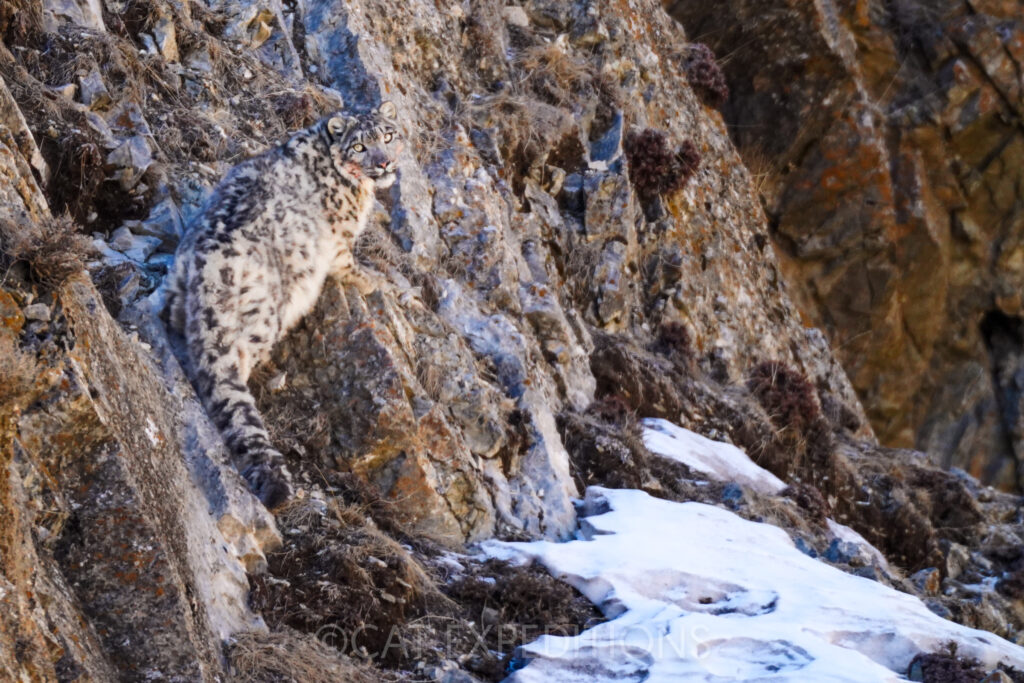
Siberian Ibex: We saw Siberian ibex daily, including a group that was unaware of a (very full!) snow leopard less than twenty meters away from them.

Detailed Snow Leopards of Mongolia Trip Summary 2024
Day 1: Everyone landed in Ulaanbaatar, the capitol of Mongolia, where we settled into the hotel for the night, after a fun dinner at the hotel. It was great to see friends, as every guest on the tour was a previous Cat Expeditions guest. Ulaanbaatar and Mongolia in general is very different in the winter time. Temperatures generally are below zero degrees and the ever present wind can test your limits for staying warm. It’s a sharp contrast to the summer we well know, but we embraced it with our fever for cat sightings.
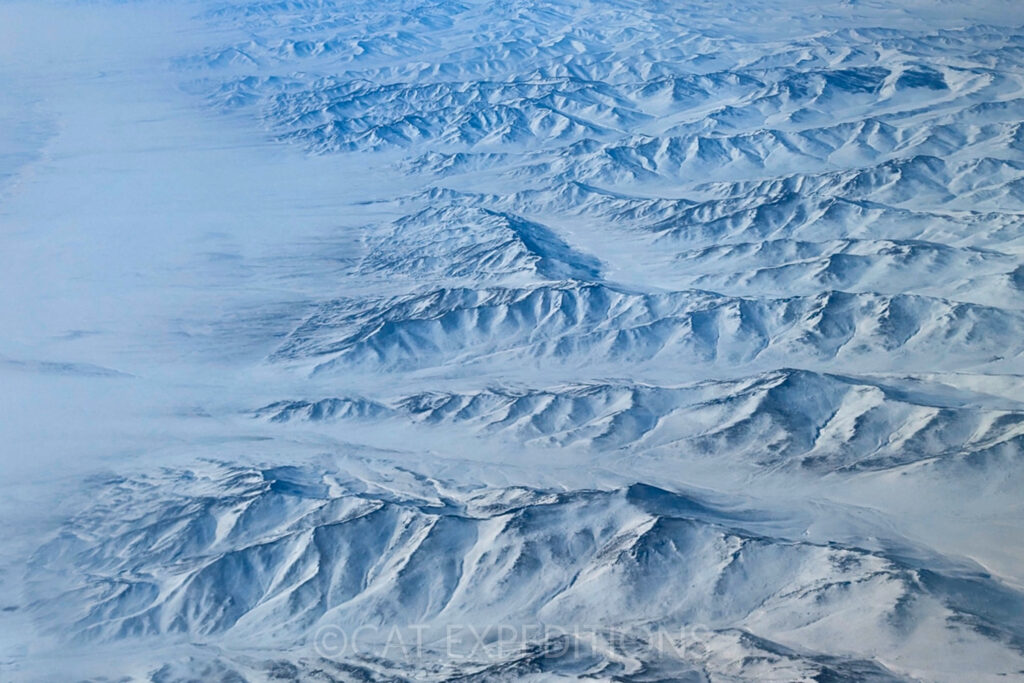
Day 2: Well, I am rather embarrassed to write this in a trip report, but it is what happened so I am not going to omit the truth. Our flight from Ulaanbaatar to eastern Mongolia was supposed to be at 11am. We decided on 6:30am breakfast giving us plenty of time to make it to the airport. It turned out the flight had been moved up to 6:50am and the ground operator who had booked the flight tickets was never notified, nor did they, or I double check to make sure things had not changed (none of us will ever make that mistake again). We of course couldn’t make this new departure time, despite calling the airline to ask them to hold the flight. We went through a few different options mentally (drive, which would take more than 24 hours, charter a helicopter flight – couldn’t validate the safety of this option, or option three, which was the one we settled on – take a commercial flight to a somewhat nearby town of our original destination. It meant we added an additional five hours drive to our travel day that day, but we made it to camp in the late evening and everyone was positive about not having missed any cat spotting time. Plus the sightings that followed in the next days well made up for the inconvenience.
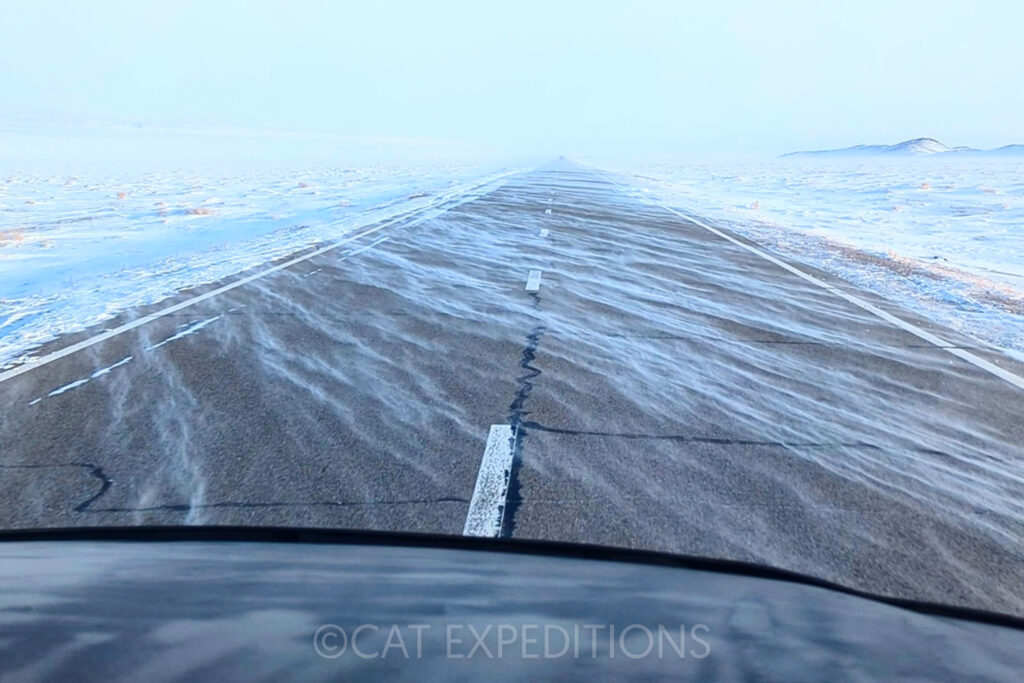
Day 3: We woke up to a beautiful star filled morning. The gers were hot, as staff came in and heated the stoves early in the morning (what service!). After a relaxed breakfast we checked out camp, including the neighbors goats and sheep (and guard dog puppy!). Around 11am we headed into the mountains and as we drove up, we found out a snow leopard had just been spotted (we hired five spotters, who the rest of the year are livestock farmers in the same area – this ensures we are giving money directly to the locals which in turn also means snow leopards are protected in the area – ecotourism as a conservation strategy!). The drive into the mountain valley floor must have only taken five minutes, but felt like half an hour, as we were all ready to see our first snow leopard – for three of the participants, it would be their first snow leopard ever!
Upon arriving to the spotters, it was that typical game with snow leopards, the masters of camouflage. The spotter knew where it was and the rest of us had no idea, not being able to see anything different but rocks upon rocks, until our cameras were put onto the cat by the spotters. It was a beautiful sub-adult male on a rock pinnacle, just resting in the morning sun. At a distance of about 300 meters we were overjoyed. One of the guests started crying having wanted to see a snow leopard for over forty years. Those are the moments we live for running these trips.
We watched the male over lunch, when he decided to come down the mountainside, towards us. Their camouflage is so remarkable that even when the cat passed over a scree field with no cover, none of us saw him do it. We lost him for a bit and then he re-appeared on a different rock formation, settling down again for some sleep.
We decided to hike up and approach the cat, keeping our eyes on him to make sure if he showed signs of distress to stop. He was happy napping while we approached him to a confirmed seventy-five meters! We settled in at that distance, watching the cat sleep, or at least his tail, which was the only thing revealing his presence. After another two hours, the cat woke up, glanced around, including at us, and then went back to sleep. It was incredible to lock eyes with the cat at that distance.
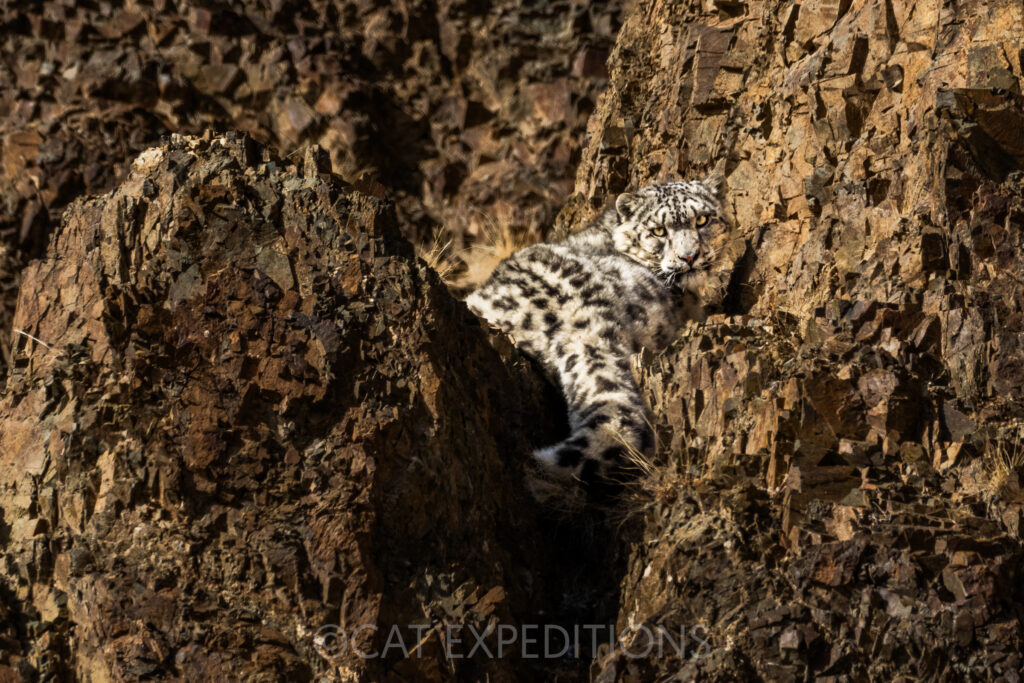
Later in the afternoon, he moved off and despite one brief glimpse of the cat looking around a boulder, we never saw him again. But it didn’t matter, that was for sure one of the best sightings we could have ever hoped for.
A delicious dumpling dinner and heated gers awaited us at camp, and we just couldn’t stop talking about the encounter we just had. The drama of the previous day was long forgotten. We all fell asleep quickly, replaying the days events over and over again.
Day 4: With the temperatures hovering at, well, really cold, and the cats requiring hours of searching before the spotters would find one (a remarkable feet) we started the day with a later breakfast and hung at the warm camp until we received a radio message telling us a cat had been spotted. In the meantime I was helping guests work on their images from the day before. At 10:30am the message came in. Another snow leopard had been spotted. Like firefighters we put on our cold weather gear as quickly as we could before driving back into the mountains. Driving by the ger of one of our spotters was a nice reminder of how local our team really was. When we drove as high as we could, we had lunch, before starting our hike towards the cat. The hike was short, but along a big scree slope so we were all very careful about our footing (which was greatly helped by hiring porters for helping carry our gear). We settled into our ridgeline spots, observing the cat that was napping in an eagle nest! After just thirty minutes a herd of ibex came incredible close to her hiding spot, but somehow she wasn’t interested in a hunt. Nonetheless the chance of a possible hunt filled us all with a ton of adrenaline. The ibex herd left and the cat fully returned to a deep sleep. The temperatures were cold, but pleasant as there was little wind. We had the privilege of watching this female snow leopard sleep for five hours, before she decided it was time to get up. Giving the tiniest amount of effort she jumped up a six foot cliff and disappeared over the ridgeline. The action was brief but it was incredible to see her move through her treacherous mountain habitat with such ease.
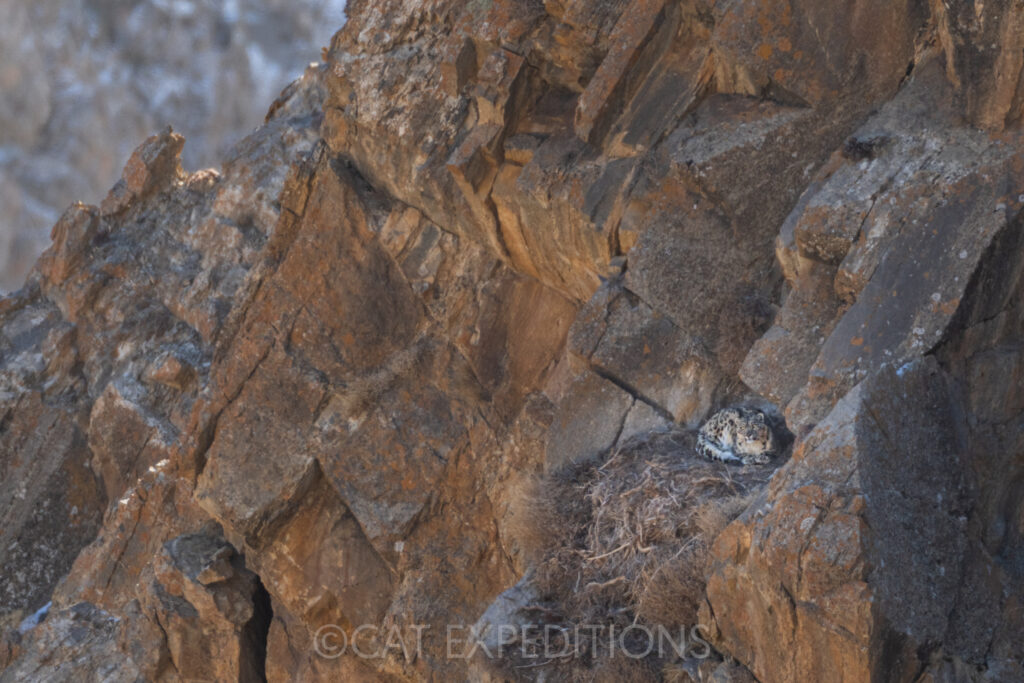
Day 5: We woke up to another beautiful, crisp morning. After an early breakfast we did some more photography around camp, and did some post-processing tutorials. At around 10am we headed back into the mountains and met up with the snow leopard spotters (no radio call had come in so we knew no sightings were made. While eating lunch, one of our drivers called out “Irbis” the Mongolian name for snow leopard. We jumped up, put out spotting scopes, binoculars and cameras towards the general area he was pointing, and realized there were two cats together. It was quite distant (how do they spot these things!), but we realized it was two sub-adults together, probably recently dispersed animals. They were up on a cliff and as quickly as we saw them they disappeared behind rocks. We would later on see one of the cats up on the ridge before it disappeared for good. Seeing these cats on the skyline is such a remarkable reminder of how these cats rule these mountains.
Day 6: In the morning we focused our sunrise photography on the valley floor, looking for saiga antelope and goitered gazelles. We found both, but they were extremely skittish (due to the regular hunting that persisted well into the 1970s). We got some distant shots, marveled at the beautiful landscape, and hung out with a herd of domestic camels. The radio went off, a snow leopard had been spotted. We raced into the mountains, hiked up an ice-filled valley to find three snow leopards high above on the cliff. They were spread out from each other, but it was incredible to see three snow leopards at the same time! We later figured out it was probably a mother and her recently dispersed cubs who had joined up to share a kill. Most of the group then went on a very steep hike to get eye level with the lowest cat. After forty-five minutes of going straight up hill, with lots of help from our hired porters, we glanced over the cliff edge to find the cat just across a small valley. It stayed for a bit before moving uphill. We could see it had blood on its face, and a very full belly. It kept looking upwards, probably at its mother who may have not wanted to share the kill. It walked straight up the mountain and with its tremendous camouflage kept disappearing out of view, despite having little cover. After about ten minutes, the cat fully disappeared into the rocks. We were all thrilled by the tremendous luck we felt to be in the mountains at the same level as the cat.

Day 7: Another morning spent trying to photograph the saiga antelope of the valley floor. Instead we found some Mongolian ground jays, and spent time photographing these curious birds. This day was our coldest, with temperatures hovering around -35 degrees and it was hard to stay warm. Rechargeable hand warmers and shoe insoles definitely helped though. Once again, we heard the radio message we always wanted to hear, a snow leopard had been spotted. We made our way up the valley, into the mountains, but when we arrived we got the disappointing news that the snow leopard had vanished. We stuck around, hoping it would show itself again. After three hours, we got another glimpse of the cat, its eyes just barely visible over a rock three hundred meters away. We watched for a while as it laid there. Two of us decided to get closer and hiked up the steep scree with the help of two porters. After a forty-five minute, exhausting hike, we were just below the cat. We crept to the edge of a rock formation to peak at the cat. No other cat is as good at camouflage and despite looking and scanning we simply couldn’t find the cat. Then, thirty minutes later, our local guide radioed from below that the cat was on the move. Again, we simply could not find it despite being less than a hundred meters away. The spotters saw it and put our cameras on it, and still we couldn’t see it. How was that possible?! The cat stopped again for a few minutes before walking up the mountainside. During this final ascent one of the spotters found the cat and placed the guests camera on the cat, who was able to take a bunch of photos. I never saw it, which was a bit disappointing, but I was so happy for the guest and once again amazed by the incredible stealth and elusiveness of the cat.
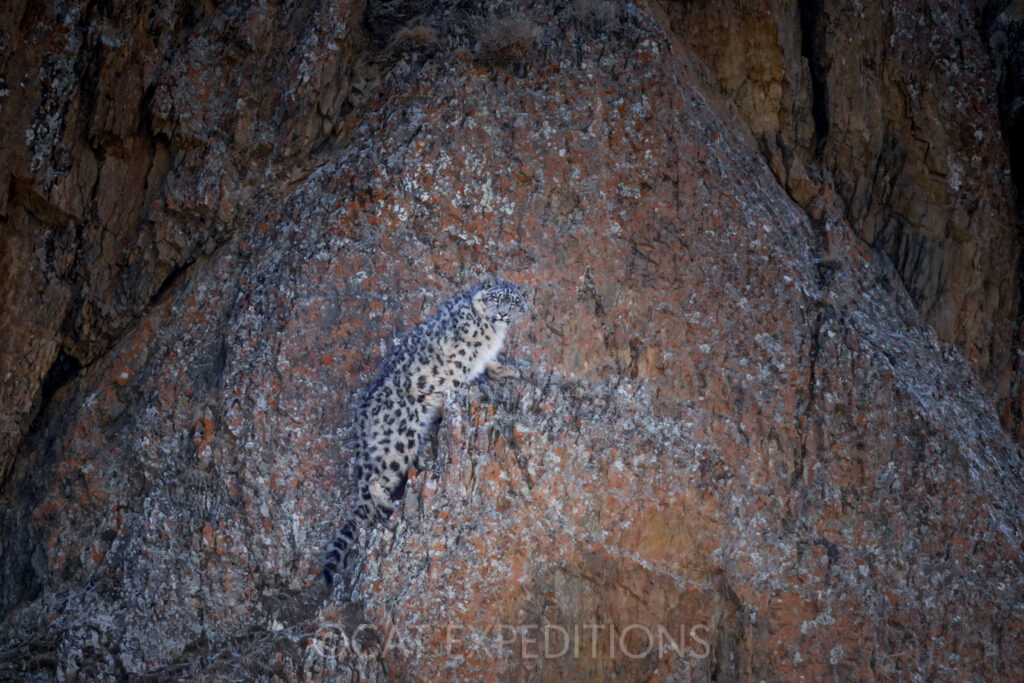
Day 8: We had an absolutely beautiful day in the mountains, but this was our only day we did not see a cat. We were all so happy with having had five days of cats before that it didn’t matter. By the end of the day, the guide and spotters were singing Mongolian folk songs, and we all just enjoyed getting to be in this incredibly beautiful place together. After a hearty dinner, we said our sad goodbyes to the spotters and guide, who were going off into the village to buy supplies and get a well deserved hot shower.
Day 9: After a very early breakfast we said our good-byes to the camp staff, flew back to Ulaanbaatar, enjoyed the luxuries of the hotel, and had a fantastic celebratory dinner!
Day 10: Everyone flew out on their international flights out of Ulaanbaatar.
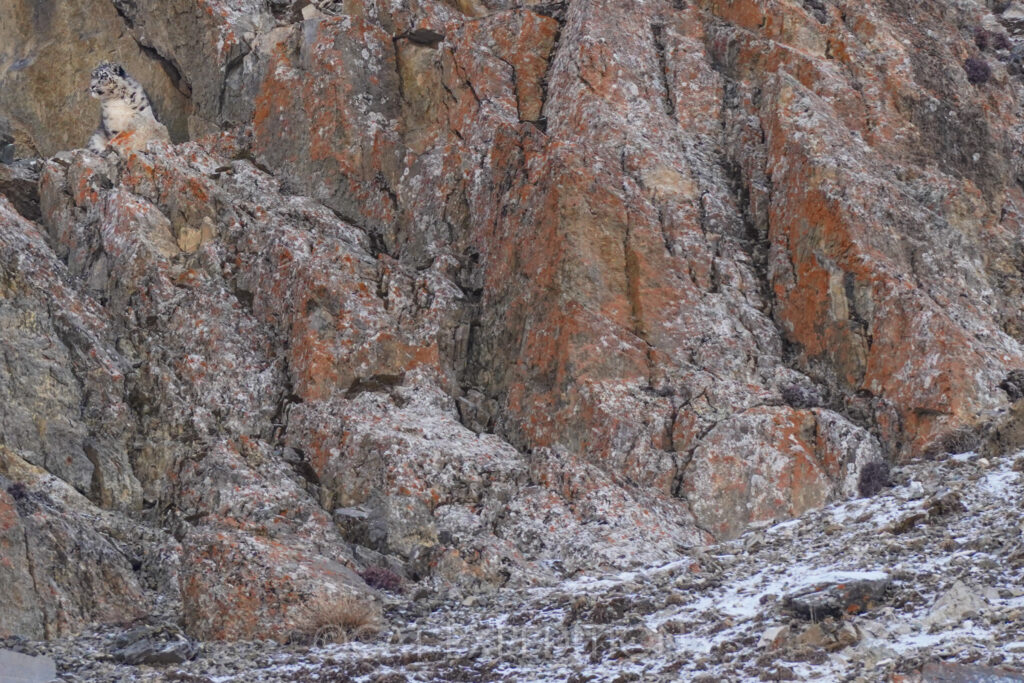
Snow Leopards of Mongolia Photo Tour 2024 Species List
Mammals
| Snow Leopard | Panthera uncia |
| Goitered Gazelle | Gazella subgutturosa |
| Saiga Antelope | Saiga tatarica |
| Siberian Ibex | Capra sibirica |
Birds
| Bearded Vulture | Gypaetus barbatus |
| Cinereous Vulture | Aegypius monachus |
| Golden Eagle | Aquila chrysaetos |
| Little Owl | Athene noctua |
| Eurasian Magpie | Pica pica |
| Horned Lark | Eremophila alpestris |
| Mongolian Ground Jay | Podoces hendersoni |
| White-winged Snow Finch | Montifringilla nivalis |
